Interviews
with Brian Muir
In order to try and make this site as informative as possible, I've taken the
opportunity of interviewing some of the original artisans, prop makers and
technicians who worked on the original Trilogy in the 70's and 80's. Elsewhere
you will see my interview with John Mollo,
the Oscar-winning costumer Designer for Star Wars and Ghandi, but here are a
couple of interviews with Brian Muir. Brian Muir was the
artist who among other things sculpted the original Darth Vader back in 1976
from Ralph McQuarries concept art. In addition he worked on C-3PO with Liz Moore
and the Stormtrooper Armour. Note that Brian
unfortunately did not have any mementos from his work on ANH, so this is mainly
text-only.
StarWarsHelmets.com Interview
with
Brian Muir
- 22nd May 2005
In order to try and make this site as informative as possible, I've taken the
opportunity of interviewing some of the original artisans, prop makers and
technicians who worked on the original Trilogy in the 70's and 80's. Elsewhere
you will see my interview with John Mollo, the Oscar-winning costumer
Designer for Star Wars and Ghandi, but here is a new piece on Brian Muir, the
artist who sculpted the original Darth Vader back in 1976. Note that Brian
unfortunately did not have any mementos from his work on ANH, so this is mainly
text-only.
-----------------------------
Brian Muir worked for Elstree Studios Art Department back in the
seventies having joined them as an apprentice. His involvement with
the Star Wars project was mainly on the Darth Vader character, but also to a
lesser extent on C-3PO, working under the overall guidance of the principal costume
designer for the movie, John Mollo. Elstree's Art Department was also
responsible for some of the props, vehicles and sets used, with work commencing
I THINK in January 1976.
1) Brian sculpted the Darth Vader helmet and armor working to designs provided by
John Mollo (we assume one of Ralph McQuarrie's illustrations). Brian
specifically sculpted Vader from a single lined sketch of Vader's 3/4 angle,
although we've not been able to trace the drawing. The photo below
from one of John Mollo's art books shows something similar from Ralph
McQuarrie, augmented by
some additional highlights from Mollo (including an unused wing section). Thanks
to John Mollo for these shots.
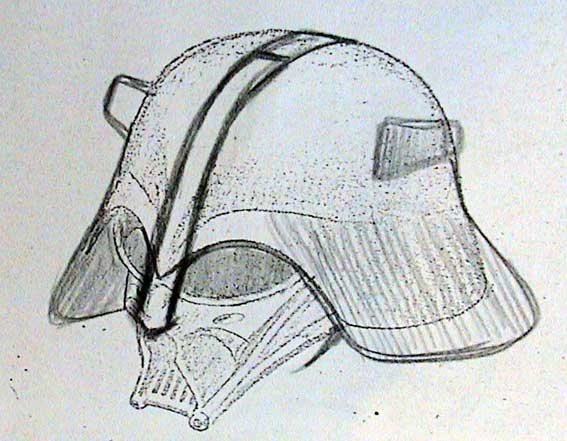
2)In order that the Vader helmet would fit the actor wearing it, they took a
life cast off Dave Prowse and Brian sculpted the helmet and hard costume pieces
around his physical dimensions (which BTW thanks to Hal9000 were; Height:
6'7", Weight: 273lbs, Chest: 50", Waist: 38", Hips: 45", Neck: 18.5", Biceps:
18")
3) Using Clay, Brian then sculpted around this "head cast" and produced
the Darth Vader face we all know and love. He sculpted the dome as a separate
piece and also the upper chest armour, leg shins etc.
4) Moulds were made of the clay face, dome and armour allowing the Fiberglass
cast helmets to be produced. This work was completed by the Elstree Plasterer’s
and Brian agreed with John Mollo's figures, believing they produced “two or
three” finished helmets, adding “they worked more on one helmet so
it was really comfortable for Dave to wear” suggesting that the majority of
filming was done with just a single helmet.
5) Though not deeply involved in the fiberglass work, he thought the moulds
would have been made from a “type of silicone with a fiberglass case to keep
it rigid”. The casts themselves were made of Fiberglass although
interestingly he thought they would have used a Black gelcoat “which would
have meant that they wouldn’t have had to paint the helmet but would have buffed
it up instead”. This could possibly explain the unique finish of the ANH
helmet dome since it may not have actually been painted.
6) He wasn’t aware of the 2-tone paint scheme (or rather the grey highlighting) – although this is not anything
unusual given the stage in the design process he worked.
Ed - it further suggests in my mind that the
grey/black colour scheme only came about after the helmet was used on-set,
in the same way as the TIE Helmets which left SDS black, yet were painted with the "Widows Tears" highlights on-screen.
7) The original clay sculpt was – wait for it – thrown in the bin, as per
normal practice. He doesn’t know what happened to the moulds and assumed
that Lucas took them back with him to the States.
8) Brian also worked on the C-3PO costume. The original sculpt was done by
Liz Moore,
again out of clay. Brian was required to take Liz’s initial sculpt and split it
up into sections and then add the detailing. He added that there was a lot of
“engineering” work required on it such that it could be worn as well as the
additional detailing”. He said that some of this was done in association with
another 3rd party company, possibly Norank.
9) Brian also worked on The Phantom Menace filmed at Leavesdon Studios in the
late nineties fabricating the large spacecraft leg (Amidala’s Naboo Cruiser?).
He had bid to produce a number of vehicles/sets/props etc. but was only
successful on the Ship leg.
I'm looking to hopefully meet up with Brian again as was clearly a major
influence on probably THE most famous screen villain. Keep checking back!
As an interesting
side issue, its recently emerged that one of
the early Prototype Vader designs by Ralph McQuarrie was later used as the basis
of the CZ-3 Jawa Sandcrawler Droid (also seen in Mos Eisley). As with the Vader,
this was sculpted by Brian Muir and was created like the Death Star Droid to
merely fulfil a background role in the movie.
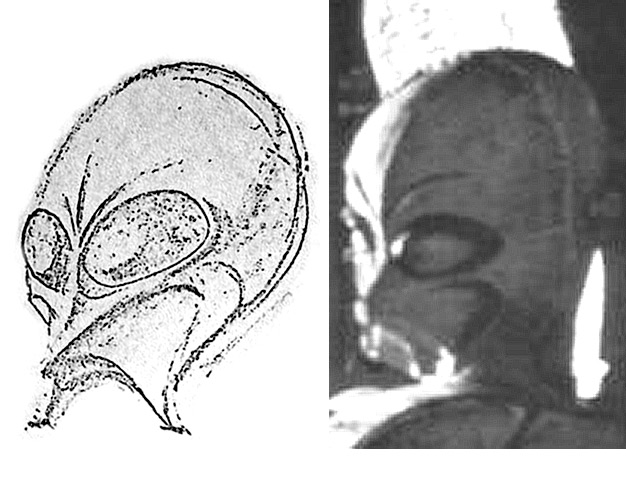
Brian's response to
this was "I sculpted Darth Vader, then CZ3 and finally the Death Star Droid.
Both droids body parts were made up from C3P0 etc"
"An old guy called Arthur Healey came on the film for a couple of weeks and
did a chest piece which I thought they had discarded but to me it looks as
though it's the one used for CZ3. The droids heads were sculpted over the
plaster cast of Anthony Daniel's head."
So although the CZ-3
drawing may have been an early design for the Darth Vader
character, the sculpt made was not a Vader prototype (if that makes
sense)
Below a better
shot of the CZ-3 Droid.
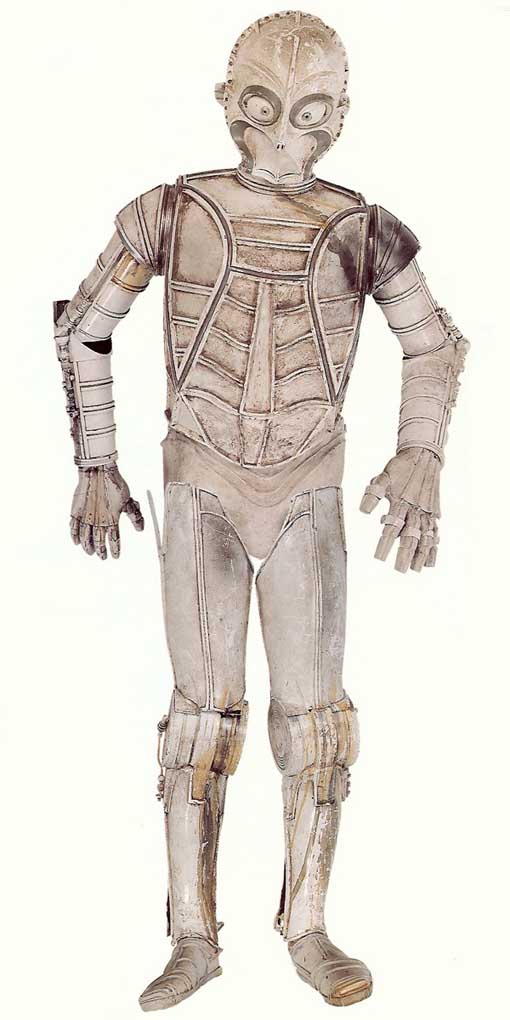
Looking at the chest
section it could also be that this was also part of the original Vader concept.
The rest of the costume looks very similar to C-3PO i.e. a collaboration between
Liz Moore and Brian Muir.
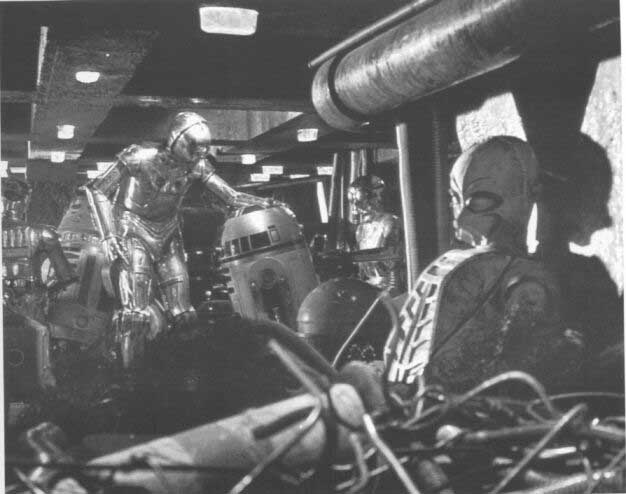
A Conversation with Brian
Muir
By SithLord (pseudonym), 2007
Darth Vader has endured as a villainous focal point for the Star Wars
saga from its inception. Based on George Lucas' concept of the dark villain,
artist and designer Ralph McQuarrie gave us our first glimpse of Darth Vader in
what are now famous sketches and paintings. Those images made it possible for
George Lucas to successfully promote his ideas to 20th Century Fox in 1975.
Production and principal photography was to take place at Elstree Studios in
England in 1976. Production designer John Barry and costume designer John Mollo
were responsible for creating a suit for Darth Vader based on the McQuarrie
concept that could be worn by actor David Prowse. However, the helmet and armor
for Vader would require an experienced fabrication team including a sculptor who
could successfully translate the two dimensional images of Vader into a three
dimensional, physical reality. As there was only a single accredited sculptor in
England at the time, that task fell quite by chance to a young sculptor by the
name of Brian Muir. Brian
Muir sculpted the helmet and armor for Darth Vader, giving life in three
dimensions to the villain conceptualized by Ralph McQuarrie. Mr. Muir's
portfolio spans over 38 years and includes such films as The Prince and the
Pauper, The Martian Chronicles, Star Wars: A New Hope, Alien (working alongside
H. R. Giger), Superman the Movie, the Indiana Jones trilogy, no less than eight
James Bond films, Clash of the Titans (working with stop-motion animation giant
Ray Harryhausen), Harry Potter and the Prizoner of Azkaban, Harry Potter and the
Order of the Phoenix, Star Wars: The Phantom Menace, Lost in Space, Alexander
the Great, Cutthroat Island, both of the Laura Croft: Tomb Raider films, and the
list goes on. I caught up with this pleasant and unassuming sculptor in his
native England and found out more about his little known role in bringing Darth
Vader to life.
When were you first approached to work on Star Wars and what were you working on
at the time?
Actually I had a break from the film industry, I had been working on churches,
houses of parliament, and I had work unveiled by the Queen, the Queen Mother,
that sort of thing. I had a phone call out of the blue by the old chap that I
had been trained under, and he said that there was a film called "Star Wars" at
Elstree Film Studios, and asked if I was interested in starting on it. Liz Moore
[the sculptress who created C-3PO] was already working on it, and I really
fancied going back into the film industry. So I said yes, I would start, and I
began work on the production in January of 1976.
You are known for sculpting the helmet and armor for Darth Vader; what was the
process in bringing Darth Vader to life in three dimensions?
I actually got a small sketch from John Mollo down in the wardrobe department
and from that design, I sculpted Darth Vader in clay onto a plaster head of Dave
Prowse. We had a certain amount of thickness we could use in clay, so that his
appearance was as threatening as possible, while I still had to make sure that
it would all fit afterwards. The mask was done separately, so the mask was then
molded and cast. I then had a cast in plaster of the mask and on top of that I
sculpted the helmet in clay. The helmet was then molded using the plaster head
as a molding ground [base] knowing full well that it would then fit back onto
the mask. Once the plasterers had molded the mask and helmet, they were actually
cast out in fiberglass with color in the resin so they were black, then maybe
they were painted as well.
How about the armor?
The shoulder armor and leg armor were actually sculpted on a plaster figure of
Dave Prowse using sketches I had from John Mollo. Because whatever I sculpted in
clay, the body becomes a molding ground so that the return of the clay when they
mold it would always be cast out so that the armor would definitely fit back
onto Dave Prowse perfectly. They would actually put foam into the back of the
armor anyway.
How long did it take you to sculpt the Darth Vader helmet?
By helmet you mean mask and helmet? I think it was roughly from memory around
about two weeks.
So it might have been one week on the mask and one week on the helmet?
No, it probably would have been a bit more on the mask, I was doing seven day
weeks so it probably would have been about 9 days on the mask and probably about
4 on the helmet.
Were you rushed?
No, I wasn't terribly rushed. I know I wasn't long on it. I did the droid heads
fairly quick, as they were about 3 or 4 days each. I spent quite a bit of time
on stuff like cleaning up afterwards. The stormtroopers took quite a fair time,
because they included legs, chest, back, arms, everything really so that was a
fair bit of time, and then carving them in the plaster again. So it was all the
processes at the time but the actual sculpting periods weren't that long. But
I'm recognized in this country as being fairly quick anyway. We re-created two
sets of the Planet of the Apes set, that originally took a year to produce in
the USA, in about six days in polystyrene.
Was there anything apart from the John Mollo sketch that inspired you when
you were sculpting the helmet of Darth Vader?
Really it was taking what I had there which wasn't much really and developing
it, and in the developing of it into three dimensions, there were just things
that happened, as strange as that may sound. From my past experience of
sculpting on various things, form comes easily from my mind, as I see things
very easily in three dimensions. So that using the basis which wasn't much
really, just an outline drawing from John Mollo that wasn't very big, I took
that and developed it into the form of Darth Vader.
Did you receive any feedback from George Lucas on your final design?
I can't remember getting any feedback from George Lucas, no. He must have been
happy with it though because he did come up a couple of times, and seemed happy
with what was going on. Whether he had a lot of other things to worry about,
maybe Darth Vader wasn't at the top of his list at the time, but the
[production] designer [John Barry] whose main responsibility was to get it
looking right, was happy as well. It was him that suggested putting the tear
ducts in [under Darth Vader's eyes] and one or two small alterations. I
definitely remember John Barry suggesting that detail under the eyes in order to
break up that area a little bit. I had very few changes to make on it, really. I
seem to remember there was one or two little things said about the tusks, maybe
I brought them out slightly further. What changes were made were made in the
clay. Just slight things but nothing major. He was quite happy with the way the
head went. On the suit of armor I think John Barry had more to say about that,
whether a line needed moving over, or formed it slightly heavier. He seemed to
have more involvement on the actual suit than the helmet. He seemed to be happy
from the word go about how it was going. John Barry was the production designer
and he had the overall say on everything design-wise, the sets, the suits,
everything.
Did you see the finished Darth Vader suit or were you able to go on set?
I did go on set and see it but one moves onto the next project. After Darth
Vader I did the droids so I was very involved up in the art department. You get
there in the morning and you sculpt away and the day goes by and, really, you
don't tend to go down on set to watch filming. And if you were seen on set
watching the filming they wanted to know what you were doing down there,
[laughs] and would say "why aren't you up in the art department doing what you
are being paid to do?"
Were you pleased with how the costume designers completed the "look" of Darth
Vader?
I was, yes. I think the cloak was a master-stroke, and I think the whole suit
came together very well. I was pleased with the overall look of it.
I understand you did some work on the sculpture of C-3PO, can you tell us a
little bit about your contribution to the look of C-3PO?
C-3PO was as you well know sculpted by Liz Moore. Liz left the picture probably
about four weeks after I started. What I did in plaster I carved the whole of
the suit up to sharpen it up so all of the edges were clean. I made some
alterations around the back of the front mask where the joint line is. I
sculpted the hands on Tony Daniels. And that's about it, really. It was probably
only a week's work, with just slight alterations. The main contribution was
really sharpening it up so that it was absolutely pristine. The slight
alterations didn't really come to that much, but they were done and I did them
and as I say the only new contribution were the hands. It was very strange
because normally they would mold Tony Daniel's hands and give me a cast of his
hands, and I would sculpt it on them. But because it was a last minute thing,
Tony actually came up to the workshop and I actually sculpted them on his hands.
Whether he would remember that or not I don't know, but it happened. It's not
something that happens every day to you is it, that someone sculpts something on
your hands.
I remember you mentioning that the sharpening that you did was to make
C-3PO's look more like metal?
Yes, to make it more like metal whereby actually all the corners were absolutely
sharper. You can carve plaster with wood carving chisels and that is what I
actually did. Wood carving chisels are extremely sharp and you can create very
sharp edges with them by cutting it extremely cleanly.
Did you sculpt any other Star Wars characters? If so can you tell us a little
bit about them?
Well, when I started off on the picture, the first thing I did was sculpted the
body armor for all of the stormtroopers. That was everything on the
stormtroopers apart from the helmet, really. It was the same process with that,
but we didn't actually do it on an actor. We got an average-sized person and
molded that and I sculpted everything on a figure. That was then molded and cast
in plaster and carved up to be sharp. After sculpting Darth Vader I went on to
do the two droid's heads based on sketches by John Mollo. [note: Protocol droid
RA-7 seen in the sandcrawler and Death Star, and secretary droid CZ-1 seen in
the sand crawler and at Mos Eisley when Luke sells his landspeeder]. I was told
at the time they were just for the [trash] compactor.
How long did you work on the Star Wars production?
It worked out to be about 5 months in the end, 20 weeks. But I worked at one
point 76 days without a day off. So I was putting in a lot of hours within that
5 months and that's probably why I turned so much work out in that period.
What was your impression of the production when you were working, and were
you told very much about the plot of the film?
I personally was told nothing about the plot whatsoever, really, other than the
very basics, that it was based on a fairy tale, on King Arthur. Really not too
much at all; we were kept in the dark to a point.
Did you get a chance to meet Ralph McQuarrie, the conceptual artist that
defined the original look of Darth Vader?
I can't remember meeting him to be honest with you. He might have come in
because he did the conceptual work on it but I can't remember meeting him.
Did you get to keep anything from the Star Wars production?
No not a single thing. The only thing I did get is the folio given to crew
members autographed with thanks from George Lucas and Gary Kurtz.
When did you see the finished version of Star Wars in theaters?
I actually went to the crew showing which is normally about a week before the
premiere showing of Star Wars, they call it a preview over here.
And what was your impression?
I thought it was fantastic. It was before its time, really. We had never seen
anything, I mean CGI or computer work, like that before. Immediately when the
large spaceship came over everyone just started clapping. This is the crew that
worked on it, and we all thought it was going to be a load of nonsense, but then
immediately we thought it was a fantastic film. At the end of the film itself it
got a standing ovation which is unheard of in crew showings really because to a
point you take it all for granted.
What was your reaction when you first saw Darth Vader appear on the screen?
My reaction was seeing my creation come to life on the screen. It was fantastic
to see it.
When Darth Vader first uttered his words to Princess Leia, what did you think
of the voice behind the mask you created? Was it the kind of voice you expected
to hear?
Well to be quite honest with you I was expecting to hear Dave Prowse' voice.
When I didn't, to be honest, I thought the voice [of James Earl Jones] was very
good. I was expecting to hear Dave Prowse because we all knew that he was in the
suit, but it obviously wasn't his voice from the get go. But it worked quite
well.
What did you think of Darth Vader re-appearing in The Empire Strikes Back and
Return of the Jedi?
Seeing the character again in the films, I thought it was fine. It was something
that I had created, and the more he was in the films, the better it was. It was
seeing your creation carry on.
Did you contribute any work to any of the Star Wars prequel movies?
Just on the first one [The Phantom Menace], I did the landing gear for Queen
Amidala's ship.
Were you pleased to see Darth Vader appear once again recently on the big
screen in Revenge of the Sith?
Again, it's a character that's become so popular over the years. It gives you a
thrill to know that you've actually created something that's become such a big
thing throughout the world. A sculptor is someone who creates, so you like to
know that people have appreciated the work you've done.
The Darth Vader helmet for Revenge of the Sith was modified a bit from your
original sculpture. What did you think of the new look of the Darth Vader
helmet?
I thought it was pretty good actually, not that I've studied it too much.
They've cleaned it up slightly from the original. It looked fine.
My four year old niece knew about Darth Vader before she even saw Star Wars,
what do you think about the longevity of the appeal of Darth Vader to fans of
all ages?
I think it will stand in time for many years to come. We are 30 years on now, so
I could see it going on and on. With the way it's going with the internet,
conventions, the fan base just seems to be growing and growing. I do see it as
an ongoing thing. Who can put how many years on something like that, but it is a
growing trend and let's hope it carries on. Having done thousands of bits of
work of varying degrees from trees and rocks to architectural work to creatures
like the space jockey [Alien 1979] and big figures, really it was just another
job. But with the fact that it will be remembered, I am quite proud having done
it.
More Vader Details from Brian
Muir
- April 2008
Brian entered the "Forum Scene" in April 2008 and was kind to answer a number of
questions from fans. The following are highlights from these dialogues on the
Prop Den.
I
was the only sculptor at Elstree once Liz Moore had left - we worked together
for 4 weeks. She had sculpted several prototypes for C3P0 heads before I started
on the film. I sculpted Darth Vader (helmet and armour), Stormtrooper armour, 2
droids heads (CZ and RA-7) and changes on C3P0. The plaster casts all had to be
sharpened up.
I
was only on the film for four and a half months so there was no time to do
prototypes of each helmet. Or maybe they were just happy with my work The
make-up dept were responsible for producing the strange characters in the
Cantina - Stuart Freeborn being head of dept.
The original Vader mask was sculpted with a front and back on a lifecast of Dave
Prowse. The complete mask was moulded and cast in plaster and I then sculpted
the helmet over it. The front and back was sculpted as one but the two halves
were only created by the moulding and casting process. ....it was very
claustrophobic and hot and was discarded.
In
order to sculpt the Darth Vader character, I was given one sketch from John
Mollo which was a 3/4 view, no shading just a line drawing. I don't know what
happened to the drawing but it hasn't appeared in any of the Star Wars books
I've seen. The character evolved in the sculpting - I wasn't given any guidance
as far as emotions etc.
The three clips on top of the mask were for connecting the back and front
together and velcro to be used for the neck area. I had no input with the
connecting mechanism - I'm not sure but I think it was Special Effects who were
responsible for it. The plaster cast was taken from the mould that was produced
from the clay mask. I then sharpened the features on the plaster head with wood
carving chisels. It was then moulded and cast in fibreglass to create the final
piece.
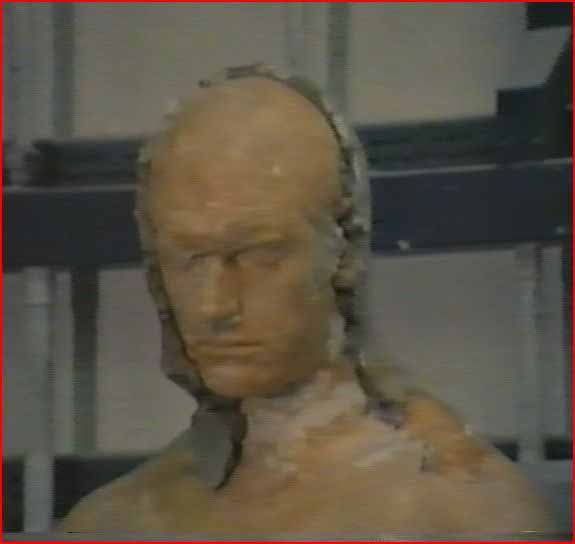
The plaster cast of Dave Prowse with clay still attached to back of head after
moulding has taken place - showing that a back was sculpted. There was only one
plaster cast. When I'd sharpened it up and it was remoulded and cast in
fibreglass I then used the same plaster cast to sculpt the clay helmet on. As
the clay sculpt took shape, changes were made in the clay under the instructions
of the Production Designer, John Barry.
Later
Brian comments and confirms that as previously thought, there were no
"Prototype" Vader helmets "no concept heads were sculpted at Elstree, just
the one screen helmet design"
As
far as "How Many Vader helmets were made", we're still not sure. Brian adds..I
saw raw castings and finished helmets but I can't say I saw all three in both
stages. The helmets would all differ as no casting would be exactly the same due
to the fact that the rubber has to be placed back into the case and it will
never sit into the case exactly the same each time. Also in the laying up of the
gel coat you can have air bubbles appear in different areas which are filled and
rubbed down. These are extremely subtle differences but nevertheless are there.
I
sculpted the mask in the sculpting shop I had in the Art Dept and then I went
into the Plaster shop to sculpt the armour afterwards. Yes, I did sculpt the
shin guards. They were cast in fibreglass along with the armour.
Click Here for
the John Mollo Interview